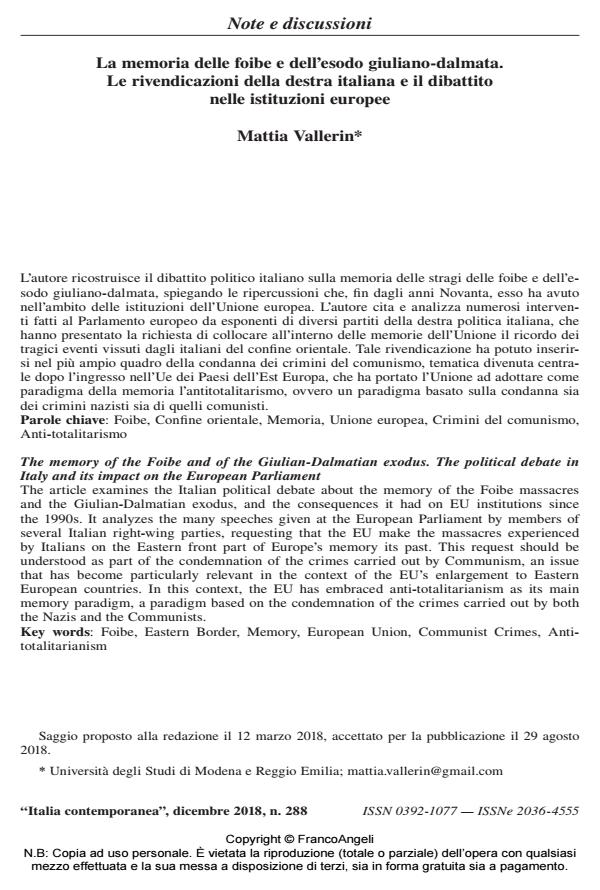The memory of the Foibe and of the Giulian-Dalmatian exodus. The political debate in Italy and its impact on the European Parliament
Journal title ITALIA CONTEMPORANEA
Author/s Mattia Vallerin
Publishing Year 2019 Issue 2018/288
Language Italian Pages 16 P. 99-114 File size 148 KB
DOI 10.3280/IC2018-288004
DOI is like a bar code for intellectual property: to have more infomation
click here
Below, you can see the article first page
If you want to buy this article in PDF format, you can do it, following the instructions to buy download credits

FrancoAngeli is member of Publishers International Linking Association, Inc (PILA), a not-for-profit association which run the CrossRef service enabling links to and from online scholarly content.
The article examines the Italian political debate about the memory of the Foibe massacres and the Giulian-Dalmatian exodus, and the consequences it had on EU institutions since the 1990s. It analyzes the many speeches given at the European Parliament by members of several Italian right-wing parties, requesting that the EU make the massacres experienced by Italians on the Eastern front part of Europe’s memory its past. This request should be understood as part of the condemnation of the crimes carried out by Communism, an issue that has become particularly relevant in the context of the EU’s enlargement to Eastern European countries. In this context, the EU has embraced anti-totalitarianism as its main memory paradigm, a paradigm based on the condemnation of the crimes carried out by both the Nazis and the Communists.
Keywords: Foibe, Eastern Border, Memory, European Union, Communist Crimes, Antitotalitarianism
- Luigi Cajani (2013), Storia, memorie e diritto penale, in Filippo Focardi, Bruno Groppo (a cura di), L’Europa e le sue memorie. Politiche e culture del ricordo dopo il 1989, Roma, Viella, pp. 245-266.
- Marina Cattaruzza (2007), L’Italia e il confine orientale, Bologna, il Mulino.
- Philip Cooke (2015), L’eredità della Resistenza. Storia, cultura, politiche dal dopoguerra a oggi, Roma, Viella.
- Guido Crainz, Raoul Pupo, Silvia Salvatici (a cura di) (2008), Naufraghi della pace. Il 1945, i profughi e le memorie divise d’Europa, Roma, Donzelli.
- Guido Crainz (2008), II difficile confronto fra memorie diverse, in Guido Crainz, Raoul Pupo, Silvia Salvatici (a cura di), Naufraghi della pace. Il 1945, i profughi e le memorie divise d’Europa, Roma, Donzelli, pp. 175-191.
- Filippo Focardi, Bruno Groppo (a cura di) (2013), L’Europa e le sue memorie. Politiche e culture del ricordo dopo il 1989, Roma, Viella.
- Filippo Focardi (2013), Il passato conteso. Transizione politica e guerra della memoria in Italia dalla crisi della prima Repubblica ad oggi, in Filippo Focardi, Bruno Groppo (a cura di), L’Europa e le sue memorie. Politiche e culture del ricordo dopo il 1989, Roma, Viella, pp. 51-90.
- Olga Gyarfasova, Karin Liebhart (eds.) (2014), Constructing and communicating EUrope, Berlino – Vienna, LIT Verlag.
- Karin Liebhart (2014), Discursive and Visual Representations of EU Presidencies: Austria, Slovenia, Czech Republic, Hungary and Poland in Comparison, in Olga Gyarfasova, Karin Liebhart (eds.), Constructing and communicating EUrope, Berlino – Vienna, LIT Verlag, pp. 53-80.
- Maria Mälksoo (2015), The Memory Politics of Becoming European, the East European subalterns and the Collective Memory of Europe, “Journal of International Relations”, 15 (4), pp. 653-680.
- Aram Mattioli (2011), «Viva Mussolini!». La guerra della memoria nell’Italia di Berlusconi, Bossi e Fini, Milano, Garzanti.
- Laure Neumayer (2015), Integrating the Central European Past into a Common Narrative: The Mobilizations Around the ‘Crimes of Communism’ in the European Parliament, “Journal of Contemporary European Studies”, 23 (3), pp. 343-363.
- Mila Orlić (2008), Poteri popolari e migrazioni forzate in Istria, in Guido Crainz, Raoul Pupo, Silvia Salvatici (a cura di), Naufraghi della pace. Il 1945, i profughi e le memorie divise d’Europa, Roma, Donzelli, pp. 25-41.
- Malgorzata Pakier, Bo Strath (eds.) (2010), A European memory? Contested Histories and Politics of Remembrance, New York – Oxford, Berghahn Books.
- Pierluigi Pallante (2006), La tragedia delle foibe, Roma, Editori Riuniti.
- Jože Pirjevec (2009), Foibe. Una storia d’Italia, Torino, Einaudi.
- Raoul Pupo, Roberto Spazzali (2003), Foibe, Milano, Bruno Mondadori.
- Raoul Pupo (2005), Il lungo esodo. Istria: le persecuzioni, le foibe, l’esilio, Milano, Rizzoli.
- Raoul Pupo (2008), Gli esodi nell’Adriatico orientale: problemi interpretativi, in Guido Crainz, Raoul Pupo, Silvia Salvatici (a cura di), Naufraghi della pace. Il 1945, i profughi e le memorie divise d’Europa, Roma, Donzelli, pp. 5-23.
- Raoul Pupo (2010), Trieste ’45, Roma-Bari, Laterza.
- Raoul Pupo (a cura di), Osimo. Il punto sugli studi, numero monografico di “Qualestoria”, Istituto Regionale per la Storia del Movimento di Liberazione in Friuli-Venezia Giulia, dicembre 2013, n. 2.
- Aline Sierp (2014), History, Memory and Trans-European Identity. Unifying Divisions, New York - Londra, Routledge.
- Federico Tenca Montini (2014), Fenomenologia di un martirologio mediatico. Le foibe nella rappresentazione pubblica dagli anni Novanta ad oggi, Udine, Kappa Vu.
- Marta Verginella (2008), Il confine degli altri. La questione giuliana e la memoria slovena, Roma, Donzelli.
- Acting at the margins – Italian mnemonic activism in the European Parliament Aline Sierp, Lorena Ortiz Cabrero, in Politique européenne /2021 pp.110
DOI: 10.3917/poeu.071.0110
Mattia Vallerin, La memoria delle foibe e dell’esodo giuliano-dalmata. Le rivendicazioni della destra italiana e il dibattito nelle istituzioni europee in "ITALIA CONTEMPORANEA" 288/2018, pp 99-114, DOI: 10.3280/IC2018-288004